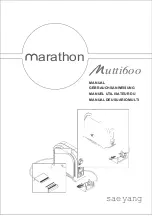
as long you hold down the button. Releasing the button will switch
the fixtures off.
2. When used in conjunction with the ADD/KILL (17) feature, these
buttons are used to activate stored channel assignments. You
may group a number of channels to be activated at once, then
store this group in one of 16 FLASH BUTTONS (1 & 13).
3. When the BLIND feature is enabled in chase mode, pressing the
SHIFT BUTTON (16) along with a channel FLASH BUTTON will
BLIND (black out) that channel.
14. Channel Indicators (9-16):
These green LEDs will glow indicating
channel activity for channels 9-16.
15. Cross Button:
This button is used to activate and deactivate Cross
Mode. Cross Mode’s activity is indicated by the Cross On and Cross
off LED indicators.
16. Shift Button:
This button is used in conjunction various other button
to access different functions.
17. Add/Kill Button:
This button is used to toggle through the ADD and
KILL functions. When in KILL mode, the yellow LED will glow.
18. Pattern Up/Button Setup Button:
This button will serve two
functions:
1. In chase or program mode, this button is used to select the next
pattern or chase. The current pattern will be displayed in the
LCD display (6). Holding down this button will quickly advance
through the patterns. Tapping this button will increase the pattern
by one.
2. When used with the SHIFT BUTTON (16), this button will select
between Channel Flash and Assign Add/Kill modes.
19. Pattern Down/Fade Time Setup Button:
This button will serve
two (2) functions:
1. In chase or program mode this button is used to decrease the
selected pattern or chase. The current pattern is displayed in the
LCD display (6). Holding down this button will quickly decrease
the patterns, tapping this button will decrease the pattern by one.
2. When used with the SHIFT BUTTON (16) this button will enable
or disable the Fade Time function. The current Fade Time function
is noted by LED indicators above the this button.
chase patterns steps, from one to the next. This CROSS FUNC-
TION will only operate with the fader channel (1-8).
5. A & B Indicators:
These LED’s are used to indicate two steps cross
fading into each other during Cross Mode.
6. LCD Display:
This high quality seven (7) segment LCD display
is used to display the present operating mode and parameters of the
running function.
7. Fade Time Fader:
This slider is used to fade steps in Chase Mode.
Fade time may be adjusted from 0.1 seconds to 5 minutes. Fade
Time is the amount of time it take the chase program to fade from
one step to the next. A fade time of 1/10 of a second would be
almost instantaneous. A fade time of 30 seconds would take 30
seconds for one step to slowly fade out and advance to the next.
8. Level Fader:
This slider acts as a master output level for the
patterns when running in Chase Mode.
9. Dimmer Speed Fader:
This slider controls the chase speed for
Channel Sliders 1-8. Chase speed can be adjusted from eight (8)
steps per second to one step per minute.
10. Switch Speed Fader:
This slider controls the chase speed for
switched channels 9-16. Chase speed can be adjusted from one
step every 30 seconds to one step every 10 minutes.
11. Audio Fader:
This unit can be set to run the chase programs to
sound. This slider adjusts the sensitivity of the internal microphone.
12. Latch Buttons (Channels 9-16):
These button serve two functions.
The Latch Buttons levels are independent from Fade Time.
When operating in Assign Mode, these button will control any
channels linked by the Assign Function.
1. In Manual Mode, they are used as ON/Off buttons for any
fixtures connect to channels 9-16.
2. In program mode, these buttons are used to trigger the various
programs that may have be assigned to these channels.
13. Flash Buttons (channels 9-16):
These button will serve three
functions:
1. In manual mode these buttons will momentarily activate any
fixtures assigned to those channels. These fixtures will remain on
©American DJ Suply® www-americandj.com Light Stantion Instruction Manual Page 5
©American DJ Suply® www-americandj.com Light Stantion Instruction Manual Page 6


























